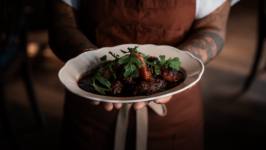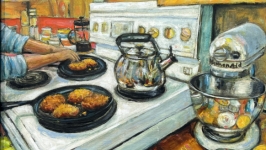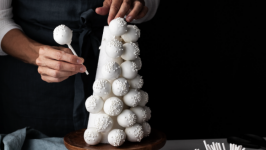Instructions
Ingredients for pastry
6½ oz (185 g) puff pastry, thawed
1 egg, lightly beaten
Ingredients for filling
4 medium Granny Smith apples
1 Tbsp (15 mL) freshly squeezed lemon juice
½ cup (125 mL) granulated sugar + extra for the pastry
¼ cup (60 mL) unsalted butter (about 58 g)
Special equipment
8-inch (20 cm) cast iron skillet (measured from the inside), or a heavy-bottomed ovenproof skillet
Method for pastry
If making handcrafted or rough puff pastry, prepare the pastry according to the instructions. If using commercial frozen puff pastry, thaw according to the instructions on the package.
Roll the pastry out onto a floured work surface, or a sheet of parchment dusted with flour, until about 1/8 inch (3 mm) thick. Cut the pastry into a 9-inch (23 cm) circle about 1 inch (2.5 cm) wider than the rim of the skillet. Transfer the circle to a plate or tray lined with parchment and dusted with flour. Wrap in plastic and refrigerate until ready to use.
Method for filling
Peel, core and halve the apples. Place in a large bowl, toss with lemon juice and set aside.
Place the sugar in an 8-inch (20 cm) cast iron skillet and moisten with 3 Tbsp (45 mL) water. Stir until the sugar is evenly moist, adding another teaspoon of water if necessary. Cook over medium heat until the sugar melts and turns a light caramel colour, about 5–8 minutes, tilting and rotating the pan as the sugar colours to help keep it uniform (the edges darken faster than the centre). Stir in the butter, off of the heat. If at any time the caramel becomes grainy just be patient, it will eventually become liquid again.
Carefully add the apple halves to the melted sugar, cut-side up. You may have to trim the apples slightly, but expect them to be bunched together rather awkwardly—they will not lie flat at this stage. They shrink as they bake and will eventually fit together snuggly.
Putting it all together
Preheat oven to 425°F (220°C).
Cover the apples with the chilled pastry and tuck the edges into the skillet so there is no overhang. (As the apples are not lying flat, the pastry will appear lumpy.)
Prick the pastry in several places with a knife or skewer to create small vents. Brush with the lightly beaten egg and dust with about 1½ Tbsp (23 mL) sugar.
Place the skillet in the preheated oven and reduce the temperature to 400°F (200°C). Bake for 20–30 minutes or until the pastry is golden and puffed and the apples are soft when pierced with a paring knife. Carefully return the tart to the stove top. Let sit for at least 30 minutes before un-molding. The pastry will deflate during the resting period and the apples will absorb the apple juices and caramel.
Using an offset knife or butter knife, lift a small corner of the pastry to check the amount of caramel/apple liquid in the pan. If your apples are still swimming in excess liquid, as sometimes happens, cook the apples over a burner on low heat for a few minutes, just until the liquid bubbles and some of the liquid evaporates. The idea is to have a moist, not runny tart.
To unmold, draw a knife around the edges of the skillet to ensure the apples and pastry aren’t sticking. Place a plate over the skillet and invert the pastry onto the plate in one swift motion. Serve warm or at room temperature.








